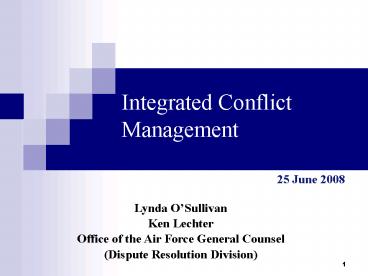Integrated Conflict Management - PowerPoint PPT Presentation
Title:
Integrated Conflict Management
Description:
Employees will evade the system if they feel their interests and needs are not being met ... element of the expected leadership skill set leaders set the tone ... – PowerPoint PPT presentation
Number of Views:51
Avg rating:3.0/5.0
Title: Integrated Conflict Management
1
Integrated Conflict Management
25 June 2008
Lynda OSullivan Ken Lechter Office of the Air
Force General Counsel (Dispute Resolution
Division)
2
Conflict
- Is conflict bad ?
- Is conflict inevitable?
- Can good things come out of conflict?
3
What is Conflict?
- Conflict is a state of discord caused by the
actual or perceived opposition of needs, values,
and interests. A conflict can be internal (within
oneself) or external (between two or more
individuals). - Conflict as taught for graduate and professional
work in conflict resolution commonly has the
definition "when two or more parties, with
perceived incompatible goals, seek to undermine
each other's goal-seeking capability".
4
Some Causes of Conflict
- Organizational Factors
- Hierarchical relationships (supervisor/employee)
allocation of resources goal differences
interdependence (mission cannot be accomplished
without cooperation among departments)
jurisdictional and accountability ambiguities
specialization and territory - Personal Factors
- Conflict management styles (avoidance,
competition, compromise, collaboration) cultural
differences (organizational, ethnic, religious,
generational) emotions perceptions
personalities values and ethics
5
Another Way to Look at Conflict
- Conflict is neither good nor badit is an
opportunity - If properly managed, conflict can be more
productive than consensus. Are we all in
agreement here? Thats not good. - Good conflict management creates trust. Trust
leads to collaboration, knowledge sharing, and
innovation.
6
Basic Principles of Conflict Resolution
- From the beginning of time, there have been three
basic approaches to resolving conflict - Power-based
- Rights-based
- Interest-based
7
Power-Based Conflict Resolution
- Example Military chain of command and
controlorders must be followed - Downsides in most organizations
- Communication is one waycan lead to bad
decisions - No buy-in/sabotage/conflict goes underground
- Bad morale, absenteeism, reduced productivity
8
Rights-Based Conflict Resolution
- Example Litigation in the courts, by-the-rules
managers - Downsides in most organizations
- Can only result in winners and losersbut in many
conflicts there is no right or wrong - Employees will evade the system if they feel
their interests and needs are not being met
9
Interest-Based Conflict Resolution
- Example Any time the relationship is important
- Focus on interests, not positions
- Explore options for mutual gain
- Separate the people from the problem
- Upsides motivated workforce, superior
productivity, culture of mutual respect and
trust, innovation, progress
10
What is an Integrated Conflict Management System?
- It is an organizational strategy
- With two main components
- 1st component emphasizes conflict management and
dispute prevention through interest-based
dialogue and problem-solving - 2nd component is a robust ADR program to
creatively and efficiently resolve disputes that
havent been prevented
11
Integrated Conflict Management System
- Elements of the ICMS
- Choosing negotiation procedures based on
interests - Choosing procedures that will do no harm to (and
hopefully improve) continuing relationships - Ensuring that conflicts are resolved at the
earliest possible stage and at the lowest
possible organizational level
12
Integrated Conflict Management System
- Elements (cont.)
- Clear organizational statement of expected
behavior engendering mutual respect and trust - Systematic training and rewards ensuring that
employees have the necessary communication and
negotiation skills - Conflict competence as a key element of the
expected leadership skill setleaders set the
tone
13
Questions?
14
Contact Information
- R. Philip Deavel, Deputy General Counsel for
Dispute Resolution, USAF--(703) 588-2211,
richard.deavel_at_pentagon.af.mil - Lynda T. OSullivan, Assistant Deputy General
Counsel for Dispute Resolution,
USAF(703)588-2210, lynda.osullivan_at_pentagon.af.mi
l - Kenneth Lechter, Associate General Counsel,
USAF(703) 588-2208, kenneth.lechter_at_pentagon.af.m
il































